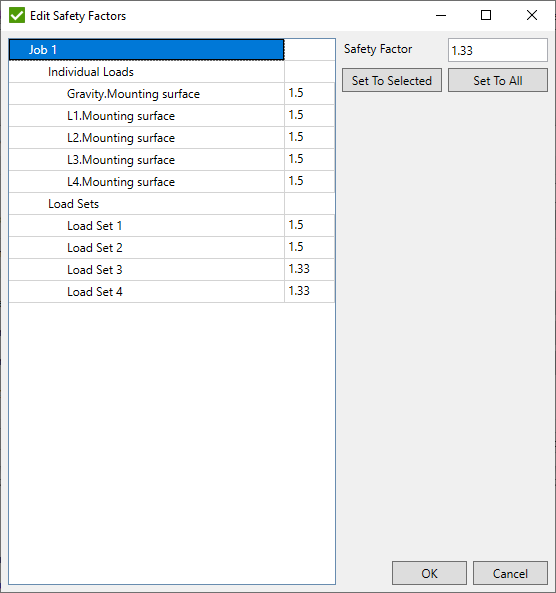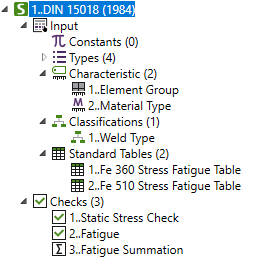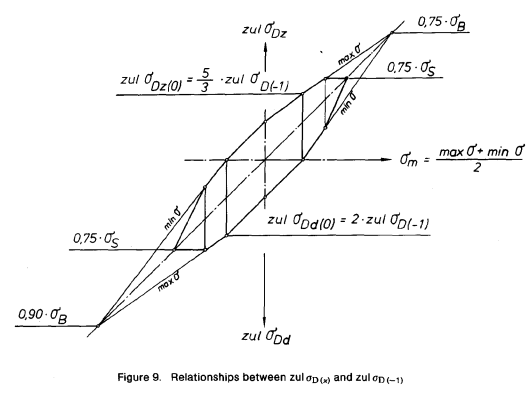DIN 15018 (1984)
DIN 15018 performs the static stress check and fatigue check for the steel structures of crane and crane equipment. Fatigue calculations are performed according to the Allowable Stress Design method (ASD).
To add DIN 15018 standard execute from the ribbon:
![]()
Press  to Set Standard Custom Settings
to Set Standard Custom Settings
To perform the fatigue check three classifications should be defined: Weld Type, Element Group and Material Type.
Weld Type - also called Notch Case, determines which elements belong to what weld type (K0-K4 - joints affected by welding, W0-W2 - elements and joints, not affected by welding). Weld Type depends on the shape, structural design, whole pattern or type and quality of the welds.
Include Rainflow Counting - include rainflow fatigue summation check with defined result category and method from which Rainflow Counting data will be used.
Note: category options for fatigue are Weld Stress or Hot Spot Stress.
Note: this option is available only for Enterprise licensing.
Element Group - depends on the Load Spectrum and Class of Utilization (number of cycles). Can be set from B1 to B6.
Load Spectrum:
| Load Spectrum | Remarks | ||
|---|---|---|---|
| S0 | Very light | P=0 | Crane by exception loaded with the working load, and as a rule, with very light loads |
| S1 | Light | P=1/3 | Crane sometimes loaded with the working load, and as a rule with loads of about 1/3 of the working load |
| S2 | Moderate | P=2/3 | Crane repeatedly loaded with the working load, and as a rule with loads between 1/3 and 2/3 of the working load |
| S3 | Heavy | P=1 | Crane frequently loaded with the working load |
Class of utilization (number of cycles):
| Class of utilization | Number of expected load cycles | Remarks | |
|---|---|---|---|
| Over | To...incl | ||
| N1 | - | 2 x 105 | Irregular use with long periods of rest |
| N2 | 2 x 105 | 6.3 x 105 | Regular use in interrupted operation |
| N3 | 6.3 x 105 | 2 x 106 | Regular use in continuous operation |
| N4 | 2 x 106 | - | Full, continuous operation |
Element Group (Table 14):
| Design load spectrum | Class of utilization | |||
|---|---|---|---|---|
| N1 | N2 | N3 | N4 | |
| S0 | B1 | B2 | B3 | B4 |
| S1 | B2 | B3 | B4 | B5 |
| S2 | B3 | B4 | B5 | B6 |
| S3 | B4 | B5 | B6 | B6 |
Material Type - define which steel is used St37 or St52.
Standard uses material data (Yield/Tensile) in calculations. Wizard checks if the values are defined for all materials.
By default, the full model is set for the selection, but it is possible to edit the selection.
Press  to define safety factors for static stress check for Individual Loads and Loads Sets:
to define safety factors for static stress check for Individual Loads and Loads Sets:

The fatigue calculations (2..Fatigue) are performed on Load Group only, stress range from load group is required. Check "3..Fatigue Summation" performs additional calculations and sum damage from different load groups based on stress history defined in Fatigue Group.

Static Check
The allowable static stress check equal to the minimum of material yield stress and 70% of tensile strength:

For the shear direction the allowable stress is divided on √3
Fatigue Check

The Kappa factor is the ratio between the minimum and the maximum stresses
Smin and Smax - minimum and maximum values of calculated result stresses;

For K-factor [-1;0]:

For K-factor (0;1]:

Where Sf – the allowable stress fatigue when K=-1. The Stress fatigue can be set by the exact value or by setting the crane group and the weld type.
Allowable fatigue stress is divided on coefficient (depends on the direction and the weld type):
Coefficient = 1 – for the normal and equivalent stresses.
Coefficient = – for the shear stress with the weld classification K0-K4.
– for the shear stress with the weld classification K0-K4.
Coefficient = – for the shear stress the with weld classification W0-W2.
– for the shear stress the with weld classification W0-W2.
Combined utilization factor fatigue is calculated using the following formula (the sign of Ufx, Ufy and Ufz are taken into the account) :

Maximum Utilization factor fatigue:

